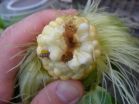(Press-News.org) Transgenic corn's suppression of the European corn borer has saved Midwest farmers billions of dollars in the past decade, reports a new study in Science.
Research conducted by several Midwest universities shows that suppression of this pest has saved $3.2 billion for corn growers in Illinois, Minnesota, and Wisconsin over the past 14 years with more than $2.4 billion of this total benefiting non-Bt corn growers. Comparable estimates for Iowa and Nebraska are $3.6 billion in total, with $1.9 billion accruing for non-Bt corn growers.
Transgenic corn is engineered to express insecticidal proteins from the bacterium Bacillus thuringiensis (Bt). Bt corn has become widely adopted in U.S. agriculture since its commercialization in 1996. In 2009, Bt corn constituted 63 percent of the U.S. crop.
Corn borer moths can't distinguish between Bt and non-Bt corn, so females lay eggs in both types of fields. Once eggs hatch in Bt corn, young borer larvae feed and die within 24 to 48 hours.
The major benefit of planting Bt corn is reduced yield losses, and Bt acres received this benefit after the growers paid Bt corn technology fees. But as a result of areawide pest suppression, non-Bt acres also experienced yield savings without the cost of Bt technology fees, and thus received more than half of the benefits from growing Bt corn in the region.
"We've assumed for some time that economic benefits were accruing, even among producers who opted not to plant Bt hybrids," said co-author of the study Mike Gray, University of Illinois Extension entomologist and professor in the Department of Crop Sciences. "However, once quantified, the magnitude of this benefit was even more impressive."
Over the past several years, entomologists and corn producers have noticed very low densities of European corn borers in Illinois. In fact, Illinois densities have reached historic lows to the point where many are questioning its pest status, Gray said.
"Since the introduction of Bt corn, initially targeted primarily at the European corn borer, many entomologists and ecologists have wondered if population suppression over a large area would eventually occur," Gray said. "As this research shows, areawide suppression has occurred and dramatically reduced the estimated $1 billion in annual losses caused previously by the European corn borer."
This information also provides incentives for growers to plant non-Bt corn in addition to Bt corn.
"Sustained economic and environmental benefits of this technology will depend on continued stewardship by producers to maintain non-Bt maize refuges to minimize the risk of evolution of Bt resistance in crop pest species," Gray said.
INFORMATION:
This study titled, "Areawide Suppression of European Corn Borer with Bt Maize Reaps Savings to Non-Bt Maize Growers," will appear in the October 8 edition of Science. The lead researcher is Bill Hutchison of the University of Minnesota. Collaborating authors include Eric Burkness and Roger Moon of the University of Minnesota, Paul Mitchell of the University of Wisconsin, Tim Leslie of Long Island University, Shelby Fleischer of Pennsylvania State University, Mark Abrahamson of the Minnesota Department of Agriculture, Krista Hamilton of the Wisconsin Department of Agriculture, Trade and Consumer Protection, Kevin Steffey and Mike Gray of the University of Illinois, Rick Hellmich of USDA-ARS, Von Kaster of Syngenta Seeds Inc., Tom Hunt and Bob Wright of the University of Nebraska, Ken Pecinovsky of Iowa State University, Tom Rabaey of General Mills Inc., Brian Flood of Del Monte Foods and the late Earl Raun of Pest Management Company.
Transgenic corn suppresses European corn borer, saves farmers billions
2010-10-08
ELSE PRESS RELEASES FROM THIS DATE:
Tinnitus in the elderly is prevalent and impacts quality of life
2010-10-08
Alexandria, VA — Tinnitus is common among elderly Nigerians and associated with treatable health conditions like otitis media, rhinosinusitis, head injury and hypertension, according to new research published in the October 2010 issue of Otolaryngology – Head and Neck Surgery.
Nearly 36 million Americans, however, suffer from tinnitus or head noises. It may be an intermittent sound or an annoying continuous sound in one or both ears. In Nigeria, tinnitus affects between 10.1% and 33% of the population, with about 3 to 4% consulting a doctor on at least one occasion in ...
New deep-sea hot springs discovered in the Atlantic
2010-10-08
Scientists from the MARUM Center for Marine Environmental Sciences and the Max Planck Institute for Marine Microbiology in Bremen on board the German research vessel Meteor have discovered a new hydrothermal vent 500 kilometres south-west of the Azores. The vent with chimneys as high as one meter and fluids with temperatures up to 300 degrees Celsius was found at one thousand metres water depth in the middle of the Atlantic Ocean. The discovery of the new deep-sea vent is remarkable because the area in which it was found has been intensively studied during previous research ...
Novel protein critical for cellular proliferation discovered
2010-10-08
Accurate duplication of genetic material and the faithful segregation of chromosomes are critical for cell survival. The initiation of DNA replication is linked both to cell cycle progression and chromatin organization. In plants, animals and other "eukaryotes," the assembly of a multi-protein complex called pre-replicative complex (preRC) is the first step in the initiation of DNA replication. As the name implies, origin recognition complex (ORC) proteins bind to origins of DNA replication. Subsequently, other components of preRC are assembled at these sites. In addition ...
An X-ray for your genes
2010-10-08
Prescription drugs and their dosages may be standardized, but not every patient reacts to a medicine in the same way. The personal genetic characteristics of individuals and populations can explain why a specific prescription successfully treats one patient and not another, so medical researchers are adopting the new approach called "personalized medicine" and a Tel Aviv University lab is leading the way.
Dr. Noam Shomron of Tel Aviv University's Sackler Faculty of Medicine is developing a new method for the advancement of personalized medicine, an expanding area of ...
Queen's University discovery could impact how the body receives medicine
2010-10-08
Researchers at Queen's University have discovered how molecules in glass or plastic are able to move when exposed to light from a laser. The findings could one day be used to facilitate medicinal drug distribution by allowing doctors to control the time and rate at which drugs are delivered into the body. The drugs, in a solid plastic carrier, could be released through the body when exposed to light.
Lead researcher Jean-Michel Nunzi, a professor in the departments of Chemistry and Physics, has determined that "molecular cooperation" is what allows the molecules to move ...
You may not be able to say how you feel about your race
2010-10-08
INDIANAPOLIS –A new study from the School of Science at Indiana University-Purdue University Indianapolis looks at how much African Americans and whites favor or prefer their own racial group over the other, how much they identify with their own racial group, and how positively they feel about themselves.
The work, by Leslie Ashburn-Nardo, Ph.D., associate professor of psychology in the School of Science at IUPUI, looked at both consciously controllable sentiments and gut feelings about social stigma and found a significant difference in both groups between what people ...
Cheek swab may detect lung cancer
2010-10-08
Early detection is critical for improving cancer survival rates. Yet, one of the deadliest cancers in the United States, lung cancer, is notoriously difficult to detect in its early stages.
Now, researchers have developed a method to detect lung cancer by merely shining diffuse light on cells swabbed from patients' cheeks.
In a new clinical study, the analysis technique--called partial wave spectroscopic (PWS) microscopy--was able to differentiate individuals with lung cancer from those without, even if the non-cancerous patients had been lifetime smokers or suffered ...
Water discovered on second asteroid, may be even more common
2010-10-08
Water ice on asteroids may be more common than expected, according to a new study that will be presented today at the world's largest gathering of planetary scientists.
Two teams of researchers who made national headlines in April for showing the first evidence of water ice and organic molecules on an asteroid have now discovered that asteroid 65 Cybele contains the same material.
"This discovery suggests that this region of our solar system contains more water ice than anticipated," said University of Central Florida Professor Humberto Campins. "And it supports the ...
Childhood adversity may lead to unhealthy stress response in adult life
2010-10-08
PROVIDENCE, R.I. [Brown University] — Seemingly healthy adults, if they were abused or neglected during childhood, may suffer physiological consequences decades later. In research published online last week by the journal Neuropsychopharmacology, a team led by psychiatrists at Brown University and Butler Hospital found that healthy adults who reported being mistreated as kids appear to have an elevated inflammatory response to stress compared to adults who had happier childhoods.
Lead author Linda Carpenter, associate professor of psychiatry and human behavior, said that ...
New study shows benefits of Bt corn to farmers
2010-10-08
A group of agricultural scientists reported in today's issue of the journal Science that corn that has been genetically engineered to produce insect-killing proteins isolated from the soil bacterium Bacillus thuringiensis (Bt) provides significant economic benefits even to neighboring farmers who grow non-transgenic varieties of corn.
"Modern agricultural science is playing a critical role in addressing many of the toughest issues facing American agriculture today, including pest management and productivity," said Agriculture Secretary Tom Vilsack. "This study provides ...





